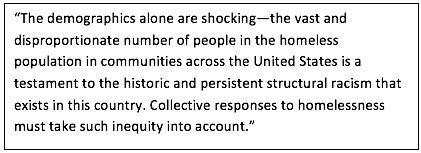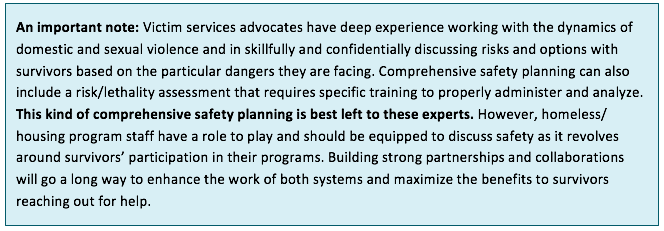By: Kris Billhardt, Technical Assistant Specialist, National Alliance for Safe Housing
It’s no secret that survivors of domestic and sexual violence make up a large percentage of the families and individuals who seek help from the homeless/housing services system. Sexual and domestic violence can compel survivors to flee their homes to escape the abuse or to distance themselves from the site of a sexual assault. Survivors may also lose their homes or be at increased risk of homelessness due to an abusive partner’s behavior. The short and long-term impacts of trauma stemming from domestic violence and sexual assault may also contribute to housing instability.

The Intersection of Homelessness and Domestic and Sexual Violence
Survivors face numerous barriers to keeping or trying to access safe housing. These challenges can force them into unsafe housing arrangements, living in danger on the streets, or even staying with or returning to the abuser just so that they and their children have beds to sleep in. Given the substantial over-representation of people of color and other marginalized populations among people experiencing homelessness throughout the country, efforts to end family homelessness must also include focused attention to cultural, racial, and linguistic considerations.
A recent study that examined Housing Management Information System (HMIS) data, took oral histories, and conducted focus groups in six U.S. communities found that more than 78% of the people experiencing homelessness were people of color – this in a country where the general population is 74% White (see http://center4si.com/wp-content/uploads/2016/08/SPARC-Phase-1-Findings-March-2018.pdf). Domestic violence was a common thread in the lives of many respondents in this study. The reality that many survivors who seek housing assistance have experienced systemic racism, discrimination, and disparate treatment from society’s institutions must consistently inform our efforts to provide meaningful services and support. For more information on the importance of bringing a racial justice framework to our efforts to end domestic violence, click here.

Safety Matters: The Importance of Collaboration Between Domestic Violence/Sexual Assault and Homelessness/Housing Experts
The multilayered intersections of homelessness, housing and domestic and sexual violence requires that both victim services providers and homeless/housing agencies know how to support survivors secure safe housing and recover from the impacts of the violence and trauma they have experienced. While victim services programs provide life-saving services to countless survivors, many lack the resources and partnerships to help all survivors with their housing needs. Survivors facing housing instability need an array of pathways to safety and stability, which often leads them to seek help through homeless/housing service providers. Addressing housing needs requires meaningful, sustained partnerships between domestic and sexual violence organizations and homeless/housing providers.
This is especially true since the U.S. Department of Housing and Urban Development (HUD) announced additional requirements for the Homeless Continuums of Care (CoC) to ensure better access for survivors, reflecting an increased emphasis on addressing the needs of individuals fleeing or attempting to flee domestic and sexual violence who seek help through the Coordinated Entry (CE) process (See Notice CPD-17-01).
Domestic and sexual violence programs can be key partners to homeless/housing service providers in integrating a safety lens into their approach to ending family homelessness in their communities. For homeless/housing providers receiving referrals from a CE process, working effectively with individuals and families whose lives have been marked by danger, injury, chaos, fear, and sabotage requires attention to safety considerations. Doing so supports homeless/housing programs’ goals, as survivors are more likely to be successful in retaining their housing if basic safeguards and supports are in place. When housing services reflect an understanding of domestic violence and sexual assault, survivors have a better chance at healing, addressing trauma impacts, and taking the reins of their lives.
A Framework of Safety for Survivors and their Families: A New Resource to Jump-Start the Conversation
Within the context of housing instability, a safety planning approach helps to ensure that individual survivors can receive tailored attention to their unique circumstances while participating in both housing and victim services programs. A safety plan is an individualized set of strategies designed to reduce risks generated by a partner’s abuse and control or in the aftermath of a sexual assault.
To equip homeless/housing providers with a foundation and basic roadmap, a safety planning toolkit for homeless/housing agencies working in partnership with domestic and sexual violence programs has been developed by the National Alliance for Safe Housing and it will be available later this month on Safe Housing Partnerships. Safety Planning for Survivors of Domestic and Sexual Violence: A Toolkit for Homeless/Housing Programs includes resources and information to boost providers’ ability to confidently offer housing services that are meaningful, safe, and grounded in best practices for a survivor population. The toolkit can also serve as a guiding framework for domestic violence and sexual assault programs when engaging their CoC and homeless/housing providers on the importance of safety planning and trauma-informed practices, and for use in providing on-going training to the CoC membership.
The toolkit covers some essential elements of homeless/housing programs’ role in providing safe and stable housing for survivors, including a look at policies, agency culture, and implementation of safety-focused protocols and practices. The toolkit also includes responses to Frequently Asked Questions and suggests other helpful resources to supplement information provided in the toolkit. To find out more, visit SafeHousingPartnerships.org.

About NASH and DVHTAC: The National Alliance for Safe Housing (NASH) is a project of the District Alliance for Safe Housing (DASH), a local safe housing program in DC. NASH is a national Technical Assistance and Training provider Project Partners: Washington State Coalition Against Domestic Violence, DC Coalition Against Domestic Violence. NASH provides programs and communities with the tools, strategies and support necessary to improve coordination between domestic and sexual violence services and homeless and housing providers, so that survivors and their children can ultimately avoid homelessness as the only means of living free from abuse.
Domestic Violence and Housing Technical Assistance Consortium: The Consortium, launched in 2015, provides training, technical assistance, and resource development at the critical intersection of homelessness and domestic violence and sexual assault. Funded by a partnership between the U.S. Department of Justice, the Department of Health and Human Services, and the Department of Housing and Urban Development, the Consortium supports a TA Team of four national organizations: Collaborative Solutions, the National Alliance for Safe Housing, the National Network to End Domestic Violence, and the National Resource Center on Domestic Violence. The Consortium works collaboratively to improve policies and practices that strengthen efforts to build safe and supportive housing options for domestic and sexual violence survivors.
 Visit SafeHousingPartnerships.org to access a comprehensive collection of online resources and to request technical assistance and support.
Visit SafeHousingPartnerships.org to access a comprehensive collection of online resources and to request technical assistance and support.














